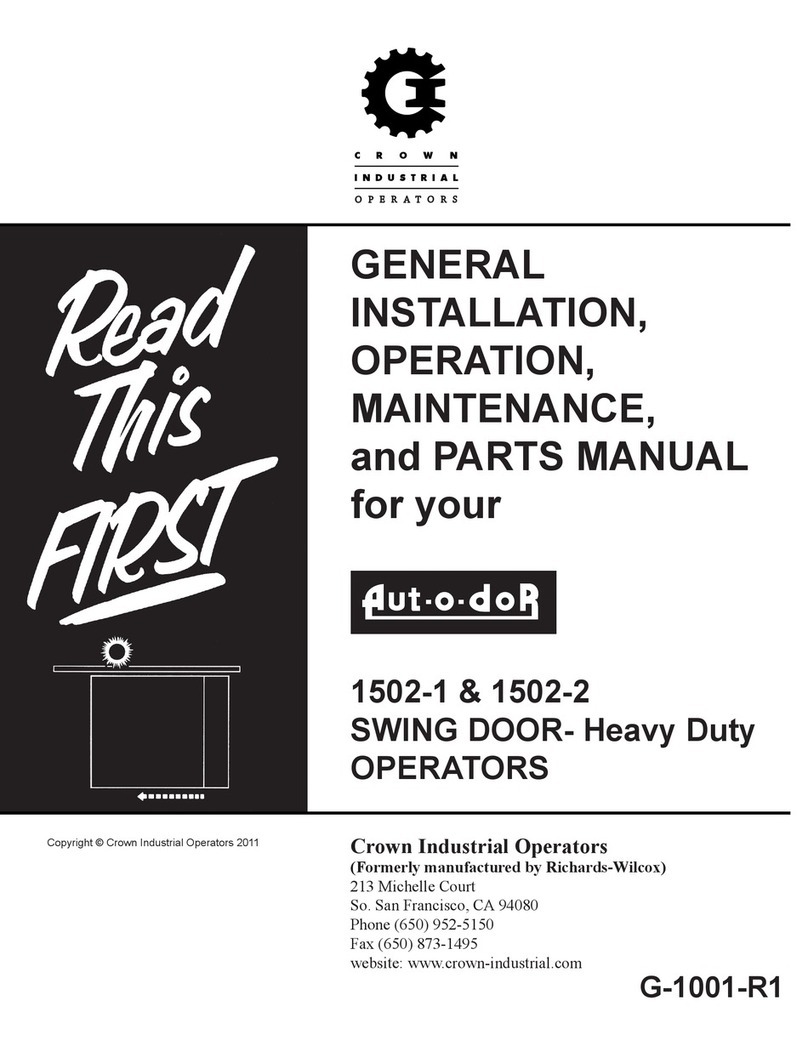
Momentary: When the actuator is depressed the
operator shall start up and continue to operate until the
appropriate limit switch is activated or a STOP button is
depressed.
IF MOMENTARY CONTROLS ARE USED CONSULT
FACTORY BEFORE PROCEEDING.
Step1:
With the mechanical disconnect disengaged and the
door free to move by hand, turn the power ON. Depress
"Open" push button. Does the Relay in the control box
labeled "O" light? If YES, proceed to step (2), if NO,
TURN POWER OFF and check the wiring from the
"OPEN" activation switch to the control box.
Step 2:
Is the operator rotating the proper direction to open the
door? If NO, turn off power to the operator control box.
Switch the motor wires typically labeled M1 & M2 or A1
& A2, located at the bottom of the control box. Turn the
power back on and check for proper rotation.
F. PRELIMINARY ROTARY LIMIT SWITCH
ADJUSTMENT
(1) DESCRIPTION: The rotary limit switch is designed
to accurately control the end limits of the door travel
provided by the electric operator as well as the activation
point and duration of the creep mode. The limit switch
input shaft drives a set of planetary gears which in
turn drives a set of nylon cams (See Figure 2). Each
precision limit switch unit is actuated by its individual
nylon cam. The cam rotate as the operator travels the
door back and forth. The cam contact the electrical
snap switches to either stop the travel of the operator or
initiate the creep modes. The limit switch has 4 switches.
(a) LSO = Limit Switch Open
This limit shuts off the electric operator when the
door reaches the full open position.
(b) LSC = Limit Switch Close
This limit shuts off the operator when the door
has reaches the full closed position.
(c) LSCO = Limit Switch Creep Open
This limit activates the creep mode during the
end of open cycle. When the limit switch is
actuated the door travels in the open direction at
a reduced speed.
(d) LSCC = Limit Switch Creep Close
This limit activates the creep mode during the
closing cycle. When this limit switch is actuated
the door travels in the closed direction at a
reduced speed.
To adjust each individual limit switch, turn the screw
adjustment for each specific limit switch. Note that
depending upon the handing of the operator the cams
travel from either the clockwise or counterclockwise
direction to activate the appropriate snap switches.
(2) PREPARATION FOR ADJUSTMENT:
(a) Disconnect the Electrical Power Supply to the
Operator Control Box.
(b) Unscrew limit switch cover and expose assembly.
(3) ROUGH ADJUSTMENT:
(a) Manually slide the door in the open direction
and note the direction the LSO cam lobe is
traveling. Clockwise or counterclockwise?
(b) Manually slide the door to approximately 6" from
the full open position.
(c) Adjust the LSO cam adjuster until the cam
contacts the electrical snap switch from the
same direction and you hear it click.
(d) Manually slide the door towards the closed
direction and back towards the open direction.
The snap switch should click when the door gets
approx. 6" from the full open position.
(e) Position the door approx. 12" from the full open
position.
(f) Turn the LSCO cam adjusting screw until the cam
contacts the electrical snap switch from the same
direction as the LSO switch and you hear it click.
Note: This cam is longer and the operator shall
only travel in closed creep mode while this cam is
depressing the snap switch.
(g) Repeat Step (d). The LSCO the snap switch
should click when the door gets approx. 12" from
the full open position.
(h) Manually slide the door to approximately 6" from
the full closed position.
(i) Turn the LSC cam adjusting screw until the cam
contacts the electrical snap switch from
the opposite direction and you hear it click.
(j) Manually slide the door towards the open
direction and back towards the closed direction.
The snap switch should click when the door gets
approx. 6" from the full closed position.
(k) Position the door approx. 12" from the fully
closed position.
(l) Turn the LSCO cam adjusting screw until the cam
contacts the electrical snap switch from the same
direction as the LSC switch and you hear it click.
Note: This cam is longer and the operator shall
only travel in open creep mode while the cam is
depressing the snap switch.
(m) Repeat step (j) LSCO the snap switch should
click when the door gets approx. 12" from the full
open position.
(n) Move the door back and forth noting that the
proper snap switches are being contacted from
the proper direction at the proper time.
Crown Industrial Operators • 213 Michelle Ct. • So. San Francisco, Ca 94080-6202
Phone: (650) 952-5150 • Fax: (650) 873-1495
G-2001 3



























